QTR-3RC Reflectance Sensor Array
Retired Product
Search for an alternativeThe QTR-3RC reflectance sensor array requires digital I/O lines to take readings. The similar QTR-3A reflectance sensor array is available with analog outputs.
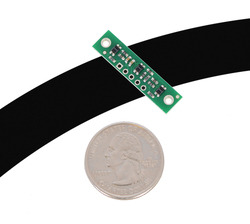 |
Functional Description
The QTR-3RC reflectance sensor array is intended as a line sensor, but it can be used as a general-purpose proximity or reflectance sensor. The module is a convenient carrier for three IR emitter and receiver (phototransistor) pairs. With sensors spaced at intervals of 0.375" (9.525 mm) along of the board’s longer axis, this array works well as a minimal detector for line-following robots, as line-following courses are commonly made using 3/4" (19 mm) black electrical tape. The middle sensor is slightly offset along the short axis of the board.
To use a sensor, you must first charge the output node by applying a voltage to its OUT pin. You can then read the reflectance by withdrawing that externally applied voltage on the OUT pin and timing how long it takes the output voltage to decay due to the integrated phototransistor. Shorter decay time is an indication of greater reflection. This measurement approach has several advantages, especially when multiple units are used:
- No analog-to-digital converter (ADC) is required
- Improved sensitivity over voltage-divider analog output
- Parallel reading of multiple sensors is possible with most microcontrollers
The LED current-limiting resistors are set to deliver approximately 17 mA to the LEDs when VCC is 5 V, making the total board consumption just over 50 mA. The schematic diagram of the module is shown below:
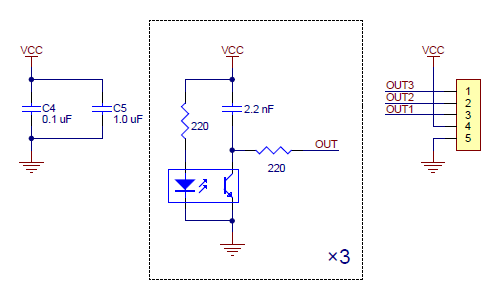 |
This schematic is also available as a downloadable pdf (117k pdf).
For an alternative array with eight sensors and the ability to turn off the IR LEDs to limit power consumption, consider Pololu's QTR-8RC reflectance sensor array. For individual reflectance sensors, consider Pololu's QTR-1RC and QTR-L-1RC.
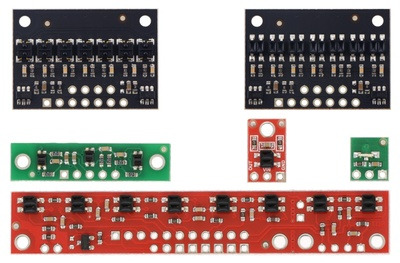 |
QTR sensor size comparison. Top row: QTRX-HD-07, QTR-HD-07; middle row: QTR-3, QTR-1, QTR-L-1; bottom row: QTR-8. |
|---|
Specifications
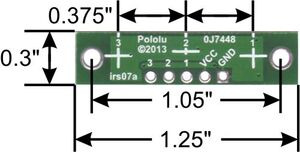 |
- Dimensions: 1.25" × 0.3" × 0.1" (32 mm × 8 mm × 3 mm) (without header pins installed)
- Operating voltage: 5.0 V
- Supply current: 50 mA
- Output format: 3 digital I/O-compatible signals that can be read as a timed high pulse
- Optimal sensing distance: 0.125" (3 mm)
- Maximum recommended sensing distance: 0.25" (6 mm)
- Weight without header pins: 0.02 oz (0.6 g)
Interfacing the QTR-3RC Outputs to Digital I/O Lines
The QTR-3RC module has three identical sensor outputs that, like the Parallax QTI, require a digital I/O line capable of driving the output line high and then measuring the time for the output voltage to decay. The typical sequence for reading a sensor is:
- Set the I/O line to an output and drive it high.
- Wait several microseconds to give the 2.2 nF capacitor node time to reach 5 V.
- Make the I/O line an input (high impedance).
- Measure the time for the capacitor node voltage to decay by waiting for the I/O line to go low.
These steps can typically be executed in parallel on multiple I/O lines.
With a strong reflectance, the decay time can be as low as several dozen microseconds; with no reflectance, the decay time can be up to a few milliseconds. The exact time of the decay depends on your microcontroller’s I/O line characteristics. Meaningful results can be available within 1 ms in typical cases (i.e. when not trying to measure subtle differences in low-reflectance scenarios), allowing up to 1 kHz sampling of all three sensors.
Pololu's Pololu AVR library provides functions that make it easy to use these sensors with Pololu's Orangutan robot controllers; please see the QTR Reflectance Sensors section of Pololu's library command reference for more information. Pololu also have a Arduino library for these sensors.
Included Components
This module has two mounting holes intended for #2 screws (not included); if the mounting holes are not needed, the ends of the PCB can be ground off to make the unit even smaller (less than 1" wide). The reflectance sensor array ships with a 1×5 straight male header strip and a1×5 right-angle male header strip as shown below. You can also solder wires, such as ribbon cable, directly to the pads for the smallest installation.
|
|
How it works in detail
For more information about how this sensor works, see the “How it works in detail” section of the QTR-1RC product page.
People often buy this product together with:
 | QTR-8A Reflectance Sensor Array |
 | QTR-8RC Reflectance Sensor Array |
 | QTR-3A Reflectance Sensor Array |
Dimensions
| Size: | 1.25" × 0.3"1 |
|---|---|
| Weight: | 0.6 g2 |
General specifications
| Supply current: | 50 mA |
|---|
Identifying markings
| PCB dev codes: | irs07a |
|---|---|
| Other PCB markings: | 0J7448 |
Notes:
- 1
- Mounting holes can be cut/ground off to decrease with to under 1".
- 2
- Without included optional headers.
Documentation and other information
-
Pololu QTR Reflectance Sensor Application Note (Printable PDF)
Information about using the Pololu QTR reflectance sensors, including differences between A-type and RC-type sensors and sample oscilloscope screen captures of sensor outputs.
-
Pololu AVR C/C++ Library User’s Guide (Printable PDF)
Information about installing and using the C/C++ libraries provided for use with Pololu products.
-
Pololu AVR Library Command Reference (Printable PDF)
A reference to commands provided in the Pololu C/C++ and Arduino libraries for the AVR.
-
Building Line Following and Line Maze Courses (Printable PDF)
Step-by-step instructions for building your own line-following courses.
File downloads
-
QTR-3RC reflectance sensor array schematic diagram (117k pdf)
Printable schematic diagram for the QTR-3RC reflectance sensor array.
-
Datasheet for the Sharp GP2S60 compact reflective photointerrupter (164k pdf)
Datasheet for the sensor used on the QTR-3RC and QTR-3A Reflectance Sensor Arrays, the Zumo 32U4 robot front sensor array, and the Optical Encoders for micro metal gearmotors.
-
Dimension diagram of the QTR-3x Reflectance Sensor Array (130k pdf)
-
Guide utilisateur du senseur QTR (suiveur de ligne) (1MB pdf)
Un guide utiliser et exploiter un senseur QTR (détecteur de ligne) (version 0.1). Note: This French translation of Pololu's QTR sensor documentation was made by Pololu's distributor MCHobby.
Recommended links
-
Matthew Phillipps ported Pololu's Arduino Library for the Pololu QTR Reflectance Sensors to the mbed platform. The Arduino library is designed to work with Pololu QTR reflectance sensors, so the mbed library should too, but Matthew points out he only tested it with the analog sensors. This library was not written and is not maintained by Pololu.
-
Arduino library for the Pololu QTR Reflectance Sensors
This library for Arduino makes it easy to interface with Pololu QTR Reflectance Sensors.
Exact shipping can be calculated on the view cart page (no login required).
Products that weigh more than 0.5 KG may cost more than what's shown (for example, test equipment, machines, >500mL liquids, etc).
We deliver Australia-wide with these options (depends on the final destination - you can get a quote on the view cart page):
- $3+ for Stamped Mail (typically 10+ business days, not tracked, only available on selected small items)
- $7+ for Standard Post (typically 6+ business days, tracked)
- $11+ for Express Post (typically 2+ business days, tracked)
- Pickup - Free! Only available to customers who live in the Newcastle region (must order online and only pickup after we email to notify you the order is ready). Orders placed after 2PM may not be ready until the following business day.
Non-metro addresses in WA, NT, SA & TAS can take 2+ days in addition to the above information.
Some batteries (such as LiPo) can't be shipped by Air. During checkout, Express Post and International Methods will not be an option if you have that type of battery in your shopping cart.
International Orders - the following rates are for New Zealand and will vary for other countries:
- $12+ for Pack and Track (3+ days, tracked)
- $16+ for Express International (2-5 days, tracked)
If you order lots of gear, the postage amount will increase based on the weight of your order.
Our physical address (here's a PDF which includes other key business details):
40 Aruma Place
Cardiff
NSW, 2285
Australia
Take a look at our customer service page if you have other questions such as "do we do purchase orders" (yes!) or "are prices GST inclusive" (yes they are!). We're here to help - get in touch with us to talk shop.
Have a product question? We're here to help!
Guides
The Maker Revolution
Projects
PiicoDev Ecosystem In Fritzing
10" Home Lab Testing Rack
WLED Hourglass Theatre Prop - DMX Over Wi-Fi!
Makers love reviews as much as you do, please follow this link to review the products you have purchased.

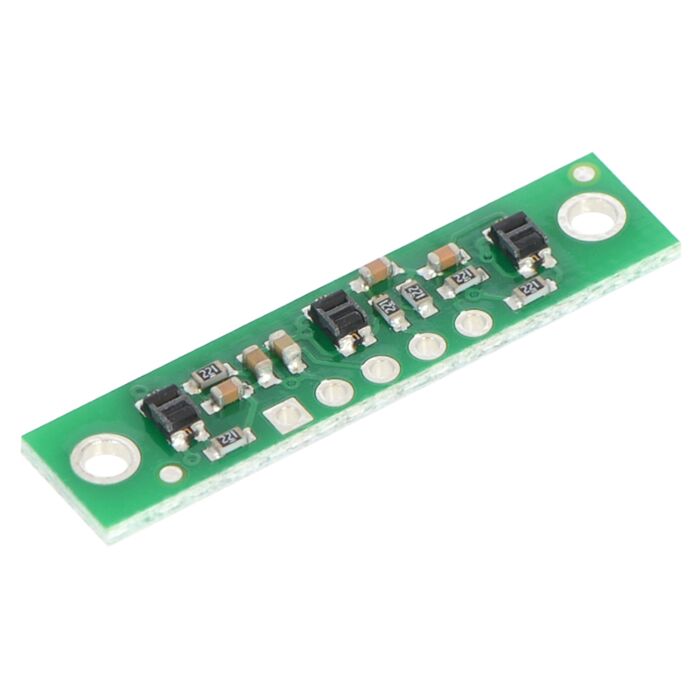

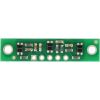
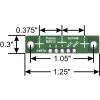
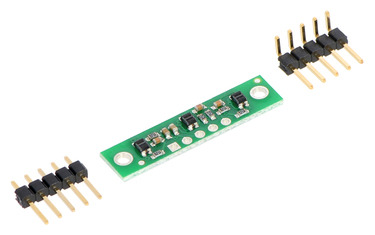
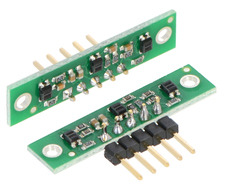





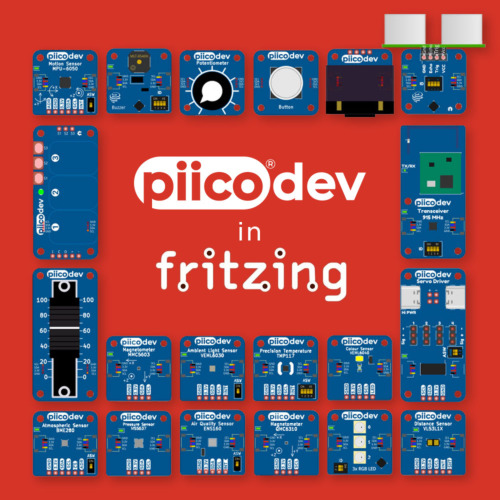



Product Comments